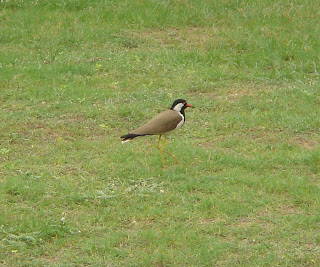Posted by
Susan Sharma
on
August 06, 2011
|
Posted by
sushil kumar
on
May 31, 2010
this is sushil from chandigarh, i have made a shrort wildlife film on ghariyal i want to screening it in film fest through iwc.
|
Posted by
Susan Sharma
on
February 26, 2010

 We, barbets are great at home building. Apart from finding something to eat, pecking a hole on the tree keeps us occupied for the best part of our life. (After all we are related to the famous woodpeckers!)
We, barbets are great at home building. Apart from finding something to eat, pecking a hole on the tree keeps us occupied for the best part of our life. (After all we are related to the famous woodpeckers!)
 When this neat hole on a wild neem tree was complete, we had reason to be proud of our handy work. We managed raising two broods inside during the summer months and our chicks are now grown up and flying about on their own. During winter, we normally fly away
to warmer climes, what are wings for anyway. It seemed appropriate to rent out our premises to other needy folks. But look at what the ants have made of it. They are really dirty housekeepers.
When this neat hole on a wild neem tree was complete, we had reason to be proud of our handy work. We managed raising two broods inside during the summer months and our chicks are now grown up and flying about on their own. During winter, we normally fly away
to warmer climes, what are wings for anyway. It seemed appropriate to rent out our premises to other needy folks. But look at what the ants have made of it. They are really dirty housekeepers.
 When the squirrels came and cleaned up the mess, we were happy. The squirrel kids were snug and warm for the winter. Not one but two families lived inside.
When the squirrels came and cleaned up the mess, we were happy. The squirrel kids were snug and warm for the winter. Not one but two families lived inside.

 The parakeets need a spacious bungalow and are now checking out the squirrel home. We barbets are sitting on the fence and watching the fight between the parakeet and the squirrel.
The parakeets need a spacious bungalow and are now checking out the squirrel home. We barbets are sitting on the fence and watching the fight between the parakeet and the squirrel.

 Hey, but why is the tree looking shrivelled up? The squirrels have been extending the house illegally from inside, eating away the sap inside.
Hey, but why is the tree looking shrivelled up? The squirrels have been extending the house illegally from inside, eating away the sap inside.
 Looking at the withering tree, we know that it will not be able to weather the next winter storm. May be it is time for us to move on to another tree! (The more you observe nature, the more you tend to identify your emotions and feelings with it. That is the
reason why I have included this blog under"anthropomorphism")
Looking at the withering tree, we know that it will not be able to weather the next winter storm. May be it is time for us to move on to another tree! (The more you observe nature, the more you tend to identify your emotions and feelings with it. That is the
reason why I have included this blog under"anthropomorphism")
|
Posted by
Susan Sharma
on
September 26, 2009



The red wattled lapwing is a regular visitor to our neighbourhood park. So I was thrilled to see three spotted eggs on the ground on 5th June. The eggs were laid in the centre of the Park which sees morning walkers doing their rounds every day (who would
not notice the eggs anyway) and young children playing football and cricket in the evenings. To protect the eggs the bird had laid the eggs underneath a tree-guard.
On 9th June, I went to check on the eggs. There was no one in the Park. But I was delighted to see two small chicks with their mother. The mother noticed me as I was still at the gate and started alarm calls. The pitch went higher and higher as I tried to
go close. The chicks scampered in one direction while the mother went in another. Soon the father lapwing appeared on the scene and started shrieking. Then, an amazing thing happened. The chicks suddenly disappeared in the grass and made themselves invisible.
Almost simultaneously, sparrows and Indian robins started flying around the area even as the parent lapwings held on to their spots.
I was mesmerised by this amazing act of community feeling! Needless to say I had to return without a photo. I could not help but feel moved enough to write this blog!
|
Posted by
Susan Sharma
on
December 18, 2007

Salmon Jumping to Freedom
Down on the fish farm, workers could not understand why the number of brown trout had suddenly taken a dive. But close observation revealed the reason - an aquatic version of the Great Escape.
The resourceful fish are leaping 3ft out of the water and into an eight-inch pipe which brings fresh water into the farm near Alresford, Hampshire. Following their instincts the trout, cousins of the Atlantic salmon, then swim against the flow
for 30ft before finding freedom at the other end as they plop into a tributary of the River Itchen. Simon Johnson, director of the Wild Trout Trust, said: “Brown trout do have migratory tendencies and swim upstream, especially in November and December. “The
water coming down from the pipe is oxygenating the pond and this could be kicking in their natural instincts. “They might well think it is a waterfall and are trying to head up it to find a place to spawn.”
The Escape Committee were caught in the act by wildlife photographer Dennis Bright, 59. A farm worker said: “It is remarkable how they manage to jump so high and through such a small pipe. “We run a low-intensity farm and like to let nature
thrive so we don’t net our ponds. As a result we lose up to 40 per cent of our stock to predators every year. “To see us losing more fish through pipes that are designed to help them is a bit of a blow. But to be honest, if I were them I would be trying to
escape too. Good luck to ‘em.” Wildlife photographer Dennis Bright, 59, captured the amazing aerobatic fish earlier this week. He said: “It was an incredible sight. “Swimming against the current is instinctive for trout as they head up stream to spawn but
they are doing a remarkable job getting through that pipe.
|
Posted by
Susan Sharma
on
September 12, 2007

A wild tusker from Jharkhand enacted a play of passion in the middle of the night, broke through the fence of a circus and eloped with a female circus elephant.
Drawn by calls of the four female elephants in the circus, the 26-year-old tusker raided the circus, broke the tin barricade and barged into the stable where the female elephants were kept, reports said.
It didn’t take long for Savitri, four years older than him, to give in to his wild charms. Despite entreaties from her keeper, the female elephant broke free of her shackles and went with him into the jungle where the residents spotted the two frolicking
near a pond.
The tale of love and passion has shocked Savitri’s manager Chandranath Banerjee, who has sought the forest department’s help to trace the female elephant. "I have never seen anything like this. Savitri’s loss could be huge as she was one of our prized elephants,"
he said.
The elephants were finally spotted moving from Badam Bagan to Nepali Para in Raniganj by a district forest officer in Durgapur, Kumar Bimal.
When a team of forest department officials along with her keeper Kalimuddin Sheikh tried cajoling Savitri to come back, she entwined her trunk around her lover’s leg in a show of defiance.
A crestfallen Kalimuddin said this was the first time she had disobeyed him.
Till late at night, the forest officials were seen trailing the pachyderms with flaming torches. They were last seen heading towards Mejia in Bankura district along the Ranigunj-Mejia Road.
Source: IANS
Reported in Indian Express dated Aug.30, 2007
|
Posted by
Susan Sharma
on
August 02, 2007

African Rats: The Best TB and Landmine Detectives
Trained giant African rats, with their extraordinary sense of smell, can detect whether or not a sputum sample contains TB indicators 48 times faster than a human lab technician. They also are brilliant at detecting mines—and won’t set them off, unlike
dogs or humans, because they are so light.
Ashoka Fellow Bart Weetjens has shown how to put these “HeroRATS” to work in Tanzania. Now he and his HeroRATS organization, APOPO, have been asked to bring this life-saving innovation to the 11 countries of the Great Lakes Region in Africa.
A HeroRAT can screen 40 sputum samples for TB in 10 minutes—a day’s work for a lab technician. HeroRATS are accredited according to International Mine Action Standards (IMAS), just like mine detection dogs, and 23 HeroRAT teams are now deployed
in Mozambique. HeroRATS are cheaper to breed, train, feed, maintain and transport; the use of HeroRATS speeds up landmine clearance and reduces operational costs; the rats are highly intelligent and social creatures, with an highly developed sense of smell;
they are adapted to the environment; and they love to perform repetitive search tasks in exchange for food rewards. Moreover, the African giant rat has a lifespan of eight years, much longer than other types of rats, and can be used for several years after
the one year training period.
APOPO now has a proven, recognized approach—and the challenge to bring it to scale quickly across 11 of Africa’s most troubled countries. APOPO is demonstrating how to do so in Tanzania. It has established a certified animal training center in Morogoro. Skilled
trainers from there then go out to the most affected parts of the country to help local people learn how to train and use the rats.
For further information (including technical reports, videos and articles), please visit the websites
www.apopo.org and
www.herorat.org.
|
Posted by
Susan Sharma
on
June 29, 2007
Here is an amusing story from Ahmedabad. A flock of sparrows has been pecking at three friends living in Ahmedabad since three days. The pecking is so severe that the men cannot go out of their homes and one day the birds even chased the men nearly a kilometer
away.
It all started from an effort by Shastri and his friends to help two fledglings, which fell from their nest after being attacked by a cat in his frontyard. "The sparrows thought we had killed her babies and started pecking us on the head." said Shastri.
The friends thought that was the end, but in the evening, they were attacked again by the sparrows near a pan shop. The next day too, the sparrows had not forgotten them. The men are now planning ways to sneak out of their homes.
Source Times of India June 29, 2007
|
Posted by
Susan Sharma
on
May 28, 2007
Both orangutans and chimpanzees share about 96 % of their DNA with humans.
In a recent study, orangutans have been named as the world’s most intelligent animal.
Once widespread throughout the forests of Asia, they are now confined to just two islands, Sumatra and Borneo.
The study has opened up the question-would it be possible to compare different species of primates for intelligence?
(From a report in Sunday Times London)
|
Posted by
Susan Sharma
on
May 20, 2007
Birdbrain is no longer a sign of stupidity; indeed it could be a sign of surprising intelligence.
Scientists Bernd Heinrich and Thomas Bugnyar reveal a series of experiments that back the idea that ravens are the brainboxes of the natural world. "These birds use logic to solve problems and some of their abilities even surpass those of the great apes."
The experiment they outline involved ravens that were allowed to sit on perches from which pieces of meat dangled from string. To get a treat, a raven had to perform a complex series of actions: pull up some of the string, place a loop on the perch and hold
it with a claw, then pull up another section of string and hold that loop on the perch. By repeating the process half a dozen times, a raven could reach the end of the string and get the meat.
Source: Guardian Newspapers Limited April, 2007
|